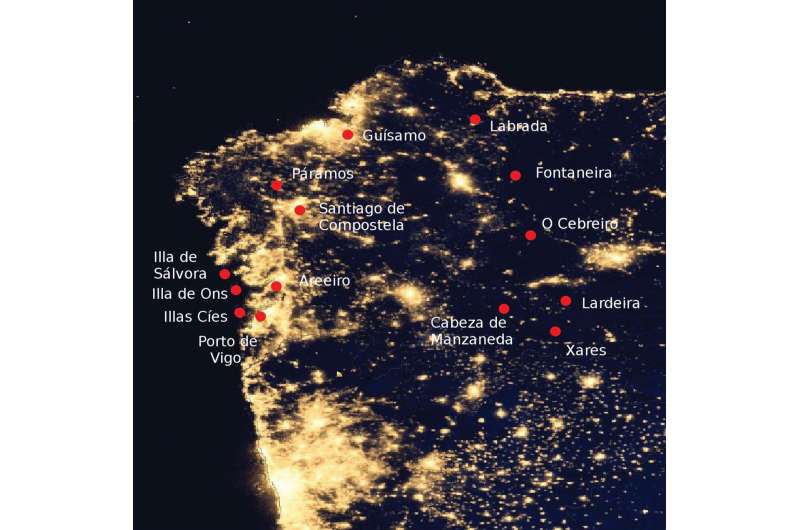October 19, 2016 report
Light detector system finds light pollution makes skies 20 times brighter in some areas

(Phys.org)—A physicist in Spain has found that artificial light systems can make the skies above cities more than 20 times as bright as natural areas. Salvador Bará, with Universidade de Santiago de Compostela has written a paper detailing sky measurements made with a sensor network set up around the northwest portion of the Iberian Peninsula highlighting just how much brighter parts of the world have become at night and has uploaded it to the open access site Royal Society Open Science.
The problem of light pollution is still so new that scientists still do not know the extent of the problems it may be causing, either for us humans or plants and animals. Eager to learn more about the amount of light pollution emitted around parts of his home country, Bará and associates put up 14 light detectors in automated weather stations around parts of the peninsula covering urban, rural and suburban areas. The detectors took readings once every minute, which were published automatically to a publicly available website. Bará defined two metrics using the data from the sensors—significant magnitude (for clear nights) and moonlight modulation factor (to account for the amount of light reflected from the moon back to Earth).
In analyzing the data, Bará found that the night sky in urban areas was typically 14 to 23 times brighter than in a natural environment. He also found light levels seven to eight times brighter in periurban areas (those on the outskirts of urban areas) and 1.6 to 2.5 times brighter in transition regions (between urban and suburban areas and rural areas) and 0.8 to 1.6 times brighter in rural or mountainous areas. He noted that the presence of clouds had a strong impact on the amount of light in the sky reaching amplification factors as high as 25.
He also notes that the night sky brightness typically attributed to moonlight was easily visible in rural and transition areas, but was barely noticeable in urban areas. He also points out that much of the artificial light that is generated encroaches on areas not meant to be lit, which represents not only waste, but possible problems for plants and animals attempting to exist at a distance.
More information: Salvador Bará. Anthropogenic disruption of the night sky darkness in urban and rural areas, Royal Society Open Science (2016). DOI: 10.1098/rsos.160541
Abstract
The growing emissions of artificial light to the atmosphere are producing, among other effects, a significant increase of the night sky brightness (NSB) above its expected natural values. A permanent sensor network has been deployed in Galicia (northwest of Iberian peninsula) to monitor the anthropogenic disruption of the night sky darkness in a countrywide area. The network is composed of 14 detectors integrated in automated weather stations of MeteoGalicia, the Galician public meteorological agency. Zenithal NSB readings are taken every minute and the results are openly available in real time for researchers, interested stakeholders and the public at large through a dedicated website. The measurements allow one to assess the extent of the loss of the natural night in urban, periurban, transition and dark rural sites, as well as its daily and monthly time courses. Two metrics are introduced here to characterize the disruption of the night darkness across the year: the significant magnitude (m1/3) and the moonlight modulation factor (γ). The significant magnitude shows that in clear and moonless nights the zenithal night sky in the analysed urban settings is typically 14–23 times brighter than expected from a nominal natural dark sky. This factor lies in the range 7–8 in periurban sites, 1.6–2.5 in transition regions and 0.8–1.6 in rural and mountain dark sky places. The presence of clouds in urban areas strongly enhances the amount of scattered light, easily reaching amplification factors in excess of 25, in comparison with the light scattered in the same places under clear sky conditions. The periodic NSB modulation due to the Moon, still clearly visible in transition and rural places, is barely notable at periurban locations and is practically lost at urban sites.
Journal information: Royal Society Open Science
© 2016 Phys.org
















